turn signal CADILLAC DEVILLE 1994 7.G Owners Manual
[x] Cancel search | Manufacturer: CADILLAC, Model Year: 1994, Model line: DEVILLE, Model: CADILLAC DEVILLE 1994 7.GPages: 399, PDF Size: 20.97 MB
Page 17 of 399
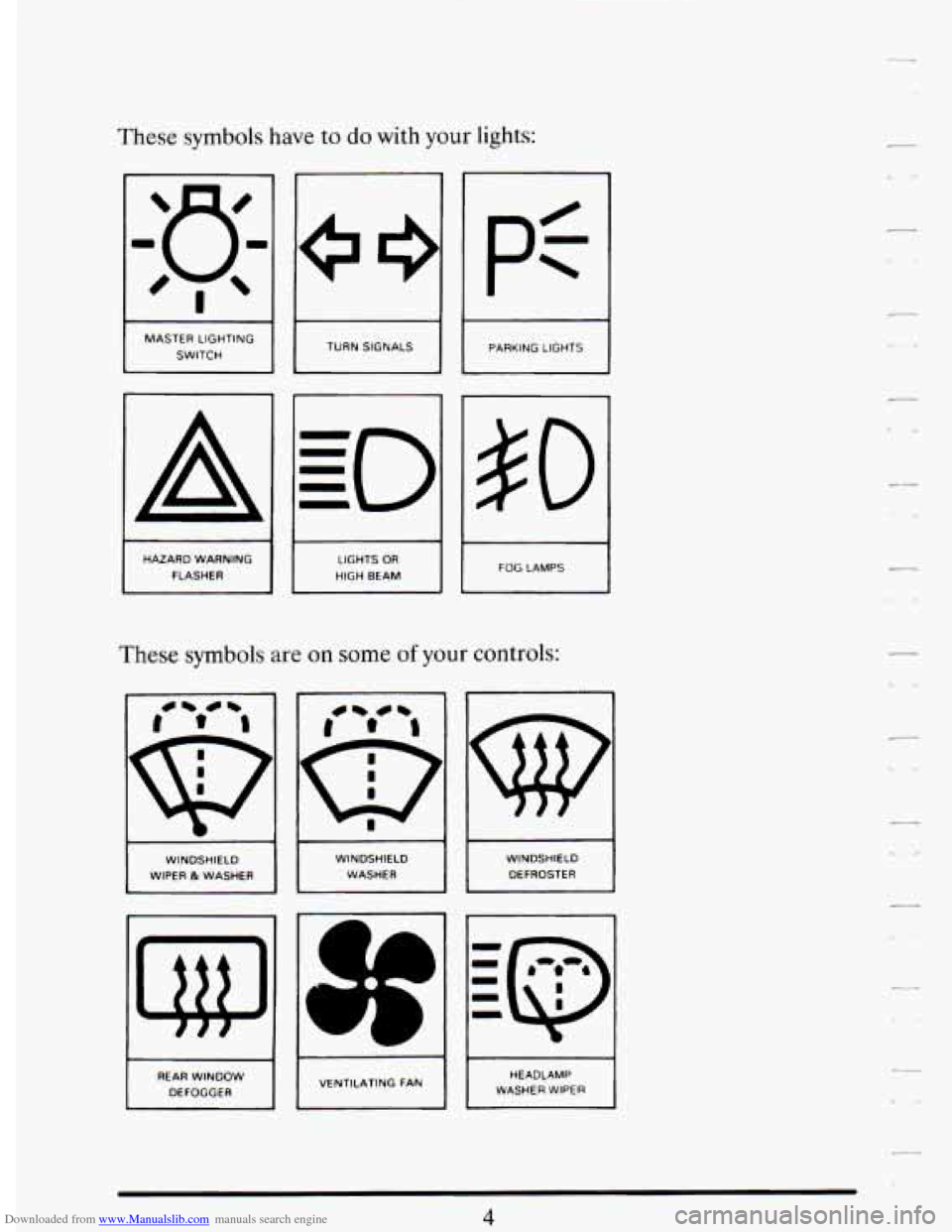
Downloaded from www.Manualslib.com manuals search engine These symbols have to do with your lights:
I
MASTER LIGHTING
SWITCH
-1
A
HAZARD WARNING
FLASHER
I
TURN SIGNALS
LIGHTS
OR HIGH BEAM PARKING LIGHTS
#O
FOG LAMPS
These symbols are on some of your controls:
I
WINDSHIELD
WIPER & WASHER I
REAR WINDOW
DEFOGGER
0
4W0b
I
WINDSHIELD WASHER
I VENTILATING FAN I
WINDSHIELD
DEFROSTER
HEADLAMP
WASHER
WIPER
r
Page 85 of 399

Downloaded from www.Manualslib.com manuals search engine .-.
Anti-Lockout Feature
Your vehicle is equipped with this feature. If you leave the key in the
ignition whether
in the Accessory, Lock, or Off position with the driver's
door open,
you can not lock your vehicle using the power locks. If you close
the door you can lock
it using the Remote Keyless Entry System. It is always
recommended that you remove
your ignition key when locking your vehicle.
When the engine is running the Anti-Lockout feature is disabled.
Illuminated Entry System
Your illuminated entry system turns on all the courtesy lights when a door
is opened or if you push the Remote Keyless Entry button. When the
door is closed, the courtesy lights
will go out.
REMOTE KEYLESS ENTRY SYSTEM
With this feature you can turn on your interior lights, lock and unlock
your doors, or unlock your
trunk from up to 15 feet (4.5 mm) using the
key chain transmitter supplied with your vehicle.
Your Remote Keyless Entry System
is intended to be used as a
supplementary vehicle entry device. It is not intended to replace, but
rather should be used in conjunction
with a door lock key. It operates on
a radio frequency subject to Federal Communications Commission
(FCC) Rules.
This device complies
with Part 15 of the FCC Rules. Operation is subject
to the following two conditions: (1) This device may not cause harmful
interference, and
(2) This device must accept any interference received,
including interference that may cause undesired operation.
Should interference to this system occur, try this:
Check
to determine if battery replacement is necessary. See the
instructions on battery replacement.
0 Check the distance. You may be too far from your vehicle. This
product has a maximum range.
0 Check the location. Other vehicles or objects may be blocking the
signal.
See your Cadillac dealer or a qualified technician for service.
-.
L
.-
.:
Y
r-
-
7
. . .a
-
'72
Page 117 of 399

Downloaded from www.Manualslib.com manuals search engine To tilt the wheel, hold
the steering wheel and
pull the lever. Move
the steering wheel to
a
comfortable level, then
release the lever to
lock the wheel in
place.
TURN SIGNA/MULTIFUNCTION LEVER
The lever on the left side of the steering column includes your:
Turn Signal and Lane Change Indicator
0 Headlight High-Low Beam
.-
104
Page 118 of 399

Downloaded from www.Manualslib.com manuals search engine I.
r
-
-
r
-
r
1
0 Flash-To-Pass Feature
Windshield Wipers
Windshield Washer
Cruise Control
Turn Signal and Lane Change Indicator Lever
The turn signal has
two upward (for Right)
and
two downward
(for Left) positions.
These positions allow
you to signal a turn or
a lane change.
To signal a turn, move the lever all the way up or down. When the turn is
finished, the lever will return automatically.
. A green arrow on the
instrument panel
will
flash in the direction of
the turn or lane
change.
I
105
Page 119 of 399
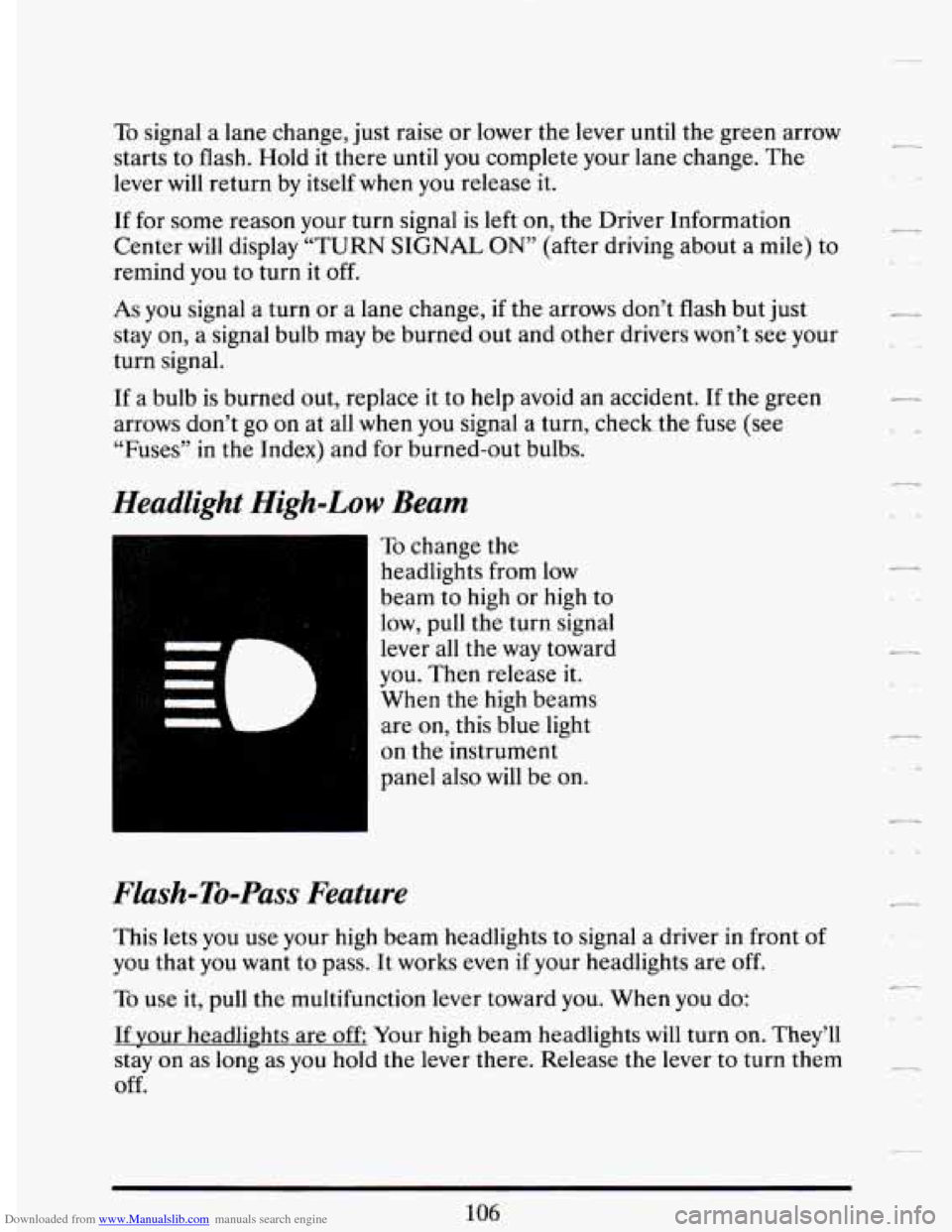
Downloaded from www.Manualslib.com manuals search engine To signal a lane change, just raise or lower the lever until the green arrow
starts to flash. Hold it there until you complete your lane change. The
lever will return by itself when
you release it.
If for some reason your turn signal is left on, the Driver Information
Center
will display “TURN SIGNAL ON” (after driving about a mile) to
remind you to turn
it off.
As you signal a turn or a lane change, if the arrows don’t flash but just
stay on,
a signal bulb may be burned out and other drivers won’t see your
turn signal.
If
a bulb is burned out, replace it to help avoid an accident. If the green
arrows don’t
go on at all when you signal a turn, check the fuse (see
“Fuses”
in the Index) and for burned-out bulbs.
Headlight High-Low Beam
I
To change the
headlights from
low
beam to high or high to
low, pull the turn signal
lever all the way toward
you. Then release it.
When the high beams
are on, this blue light
on the instrument
panel also will be
on.
Flash-To-Pass Feature
This lets you use your high beam headlights to signal a driver in front of
you that you want to pass. It works even if your headlights are
off.
To use it, pull the multifunction lever toward you. When you do:
If vour headlights are
off Your high beam headlights will turn on. They’ll
stay on as long as you hold the lever there. Release the lever to turn them
off.
106
Page 130 of 399
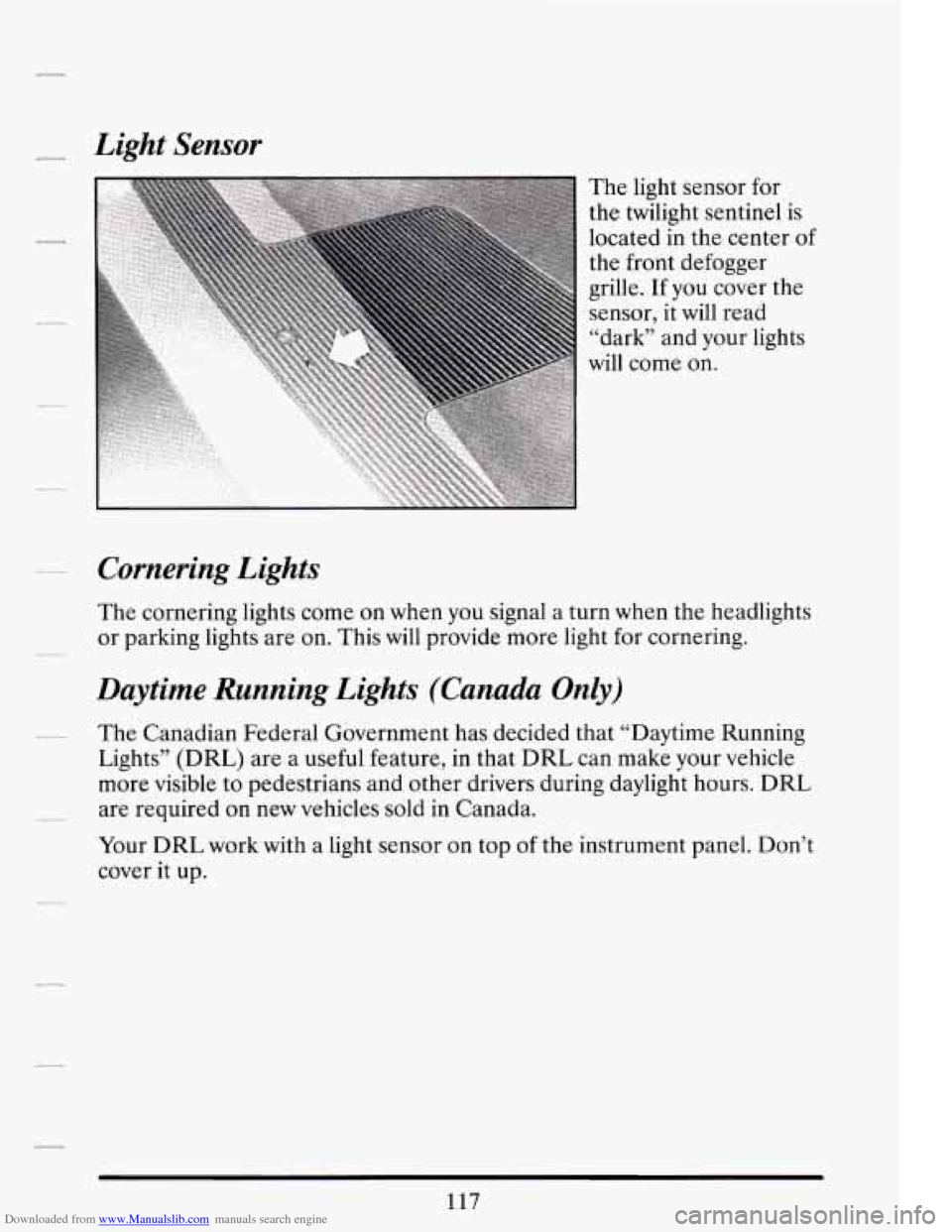
Downloaded from www.Manualslib.com manuals search engine - Light Sensor
Cornering Lights
The light sensor for
the twilight sentinel is
located
in the center of
the front defogger
grille. If
you cover the
sensor, it will read
“dark” and your lights
will come on.
The cornering lights come
on when you signal a turn when the headlights
or parking lights are on. This will provide more light for cornering.
Daytime Running Lights (Canada Only)
The Canadian Federal Government has decided that “Daytime Running
Lights”
(DRL) are a useful feature, in that DRL can make your vehicle
more visible to pedestrians and other drivers during daylight hours. DRL
are required on new vehicles sold in Canada.
Your DRL work with a light sensor on top
of the instrument panel. Don’t
cover it up.
117
Page 145 of 399
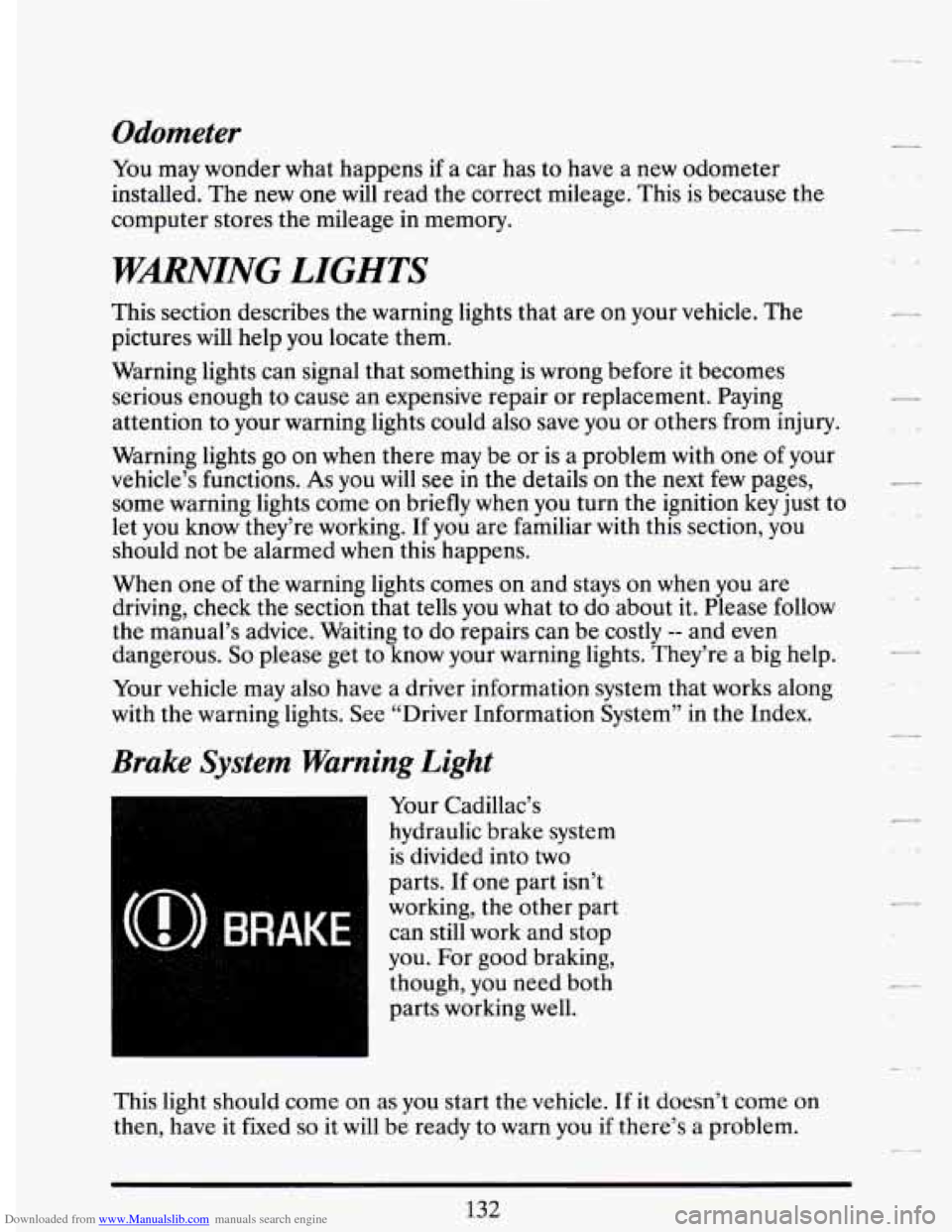
Downloaded from www.Manualslib.com manuals search engine Odometer
You may wonder what happens if a car has to have a new odometer
installed. The new one will read the correct mileage. This is because the
computer stores the mileage in memory.
WMING LIGHTS
This section describes the warning lights that are on your vehicle. The
pictures will help you locate them.
Warning lights can signal that something is wrong before it becomes
serious enough to cause an expensive repair or replacement. Paying
attention to your warning lights could also save you or others from injury.
Warning lights
go on when there may be or is a problem with one of your
vehicle’s functions.
As you will see in the details on the next few pages,
some warning lights come on briefly when you turn the ignition key just to
let you know they’re working. If you are familiar with this section, you
should not be alarmed when this happens.
When one
of the warning lights comes on and stays on when you are
driving, check the section that tells you what to do about it. Please follow
the manual’s advice. Waiting to do repairs can be costly
-- and even
dangerous.
So please get to know your warning lights. They’re a big help.
Your vehicle may also have a driver information system that works along
with the warning lights. See “Driver Information System” in the Index.
Brake System Warning Light
Your Cadillac’s
hydraulic brake system
is divided into
two
parts. If one part isn’t
working, the other part
can still work and stop
you. For good braking,
though, you need both
parts working
well.
r
L-l
This light should come on as you start the vehicle. If it doesn’t come on
then, have it fixed so it will be ready to warn you if there’s a problem.
Page 160 of 399

Downloaded from www.Manualslib.com manuals search engine TURN SIGNAL ON - 20
This message is a reminder, after driving about a mile, that you have your
turn signal on. r- e
r
i
I
i
F
i I
n
TRUNK OPEN - 24
This message indicates that your trunk is open when the ignition is ON.
VERY LOW REFRIGERANT A/C COMPRESSOR OFT - 12
This message means that the Air Conditioning System detects a
refrigerant level that is low enough to cause damage to the A/C
compressor. To avoid damage, the A/C compressor automatically turns
off and the Electronic Climate Control will automatically switch from
“AUTO” to “ECON” and remain there. Have your A/C system serviced
if
this message appears.
Speed Sensitive Steering (SSS)
This system varies the amount of steering effort proportionate to your
vehicle speed. Steering is easier at a lower speed for increased
maneuverability and parking ease.
As your vehicle speed increases, the
steering effort is also increased proportionately. At highway speeds the
amount
of steering effort is greatly increased to provide a manual like
steering feel for maximum control and enhanced vehicle stability.
Speed Sensitive Suspension
The Speed Sensitive Suspension automatically controls the ride of your
vehicle. The system controls damping forces in the shock absorbers and
struts in response to various speed and road conditions. There are three
dampening modes: Comfort, Normal and Firm. As the vehicle speed
increases, the firmness of the suspension increases. The system is in the
Comfort mode, for speeds less than
40 mph (65 km), normal mode for
speeds between 40 mph
(65 km) and’70 mph (110 km/h), and firm for
speeds greater than 70 mph
(1 10 km/h). The system also stiffens damping
during hard acceleration, braking and cornering for increased control.
The Speed Sensing Suspension controller is a computer used to control
and monitor the system. The computer receives inputs from acceleration
and determines optimum mode strut valving
(or suspension stiffness) for
your current operating conditions. The computer also receives feedback
147
Page 170 of 399

Downloaded from www.Manualslib.com manuals search engine The system will go off after a four minute heating cycle. If you shift out of
“P” (Park), the system will only cycle for two minutes. If you want it to
cycle again, push the switch. It will go on for
two minute cycles after that.
If it has cleared your windshield before the cycle is over, you can turn it
off by just pushing the switch again.
Use the defroster to clear the windshield. In warm weather the heated
windshield system helps keep the vehicle’s interior cool by blocking much
of the sun’s heat producing radiation. The system’s solar control
properties also help reduce interior fading.
There is a metal film in the windshield which will block out some radio or
microwave signals. Therefore, the heated windshield will reduce the
useful range
of devices such as garage door openers and radar detectors.
(In certain states radar detectors are legal.)
SOUND SYSTEMS
Your Delco@ sound system has been designed to operate easily and give
years
of listening pleasure. But you will get the most enjoyment out of it if
YOU acquaint yourself with it first. Find out what your Delco@ system can
do and how to operate all its controls, to be sure you’re getting the most
out
of the advanced engineering that went into it.
FM Stereo
-
FM stereo will give you the best sound. But FM signals will reach only
about
10 to 40 miles (16 to 65 km). And, tall buildings or hills can
interfere with
FM signals, causing the sound to come and go.
AM
.-.
The range for most AMstations is greater than for FM, especially at
night. The longer range, however, can cause stations to interfere with
each other.
AM can pick up noise from things like storms and power
lines. Try reducing the treble
to reduce this noise if you ever get it.
This means your radio can produce quality
AM sound comparable to FM
stereo. AMAX@ reduces noise without reducing the high frequencies you
need for the best sound. In addition
to improved sound quality, AMAX@
157
Page 187 of 399
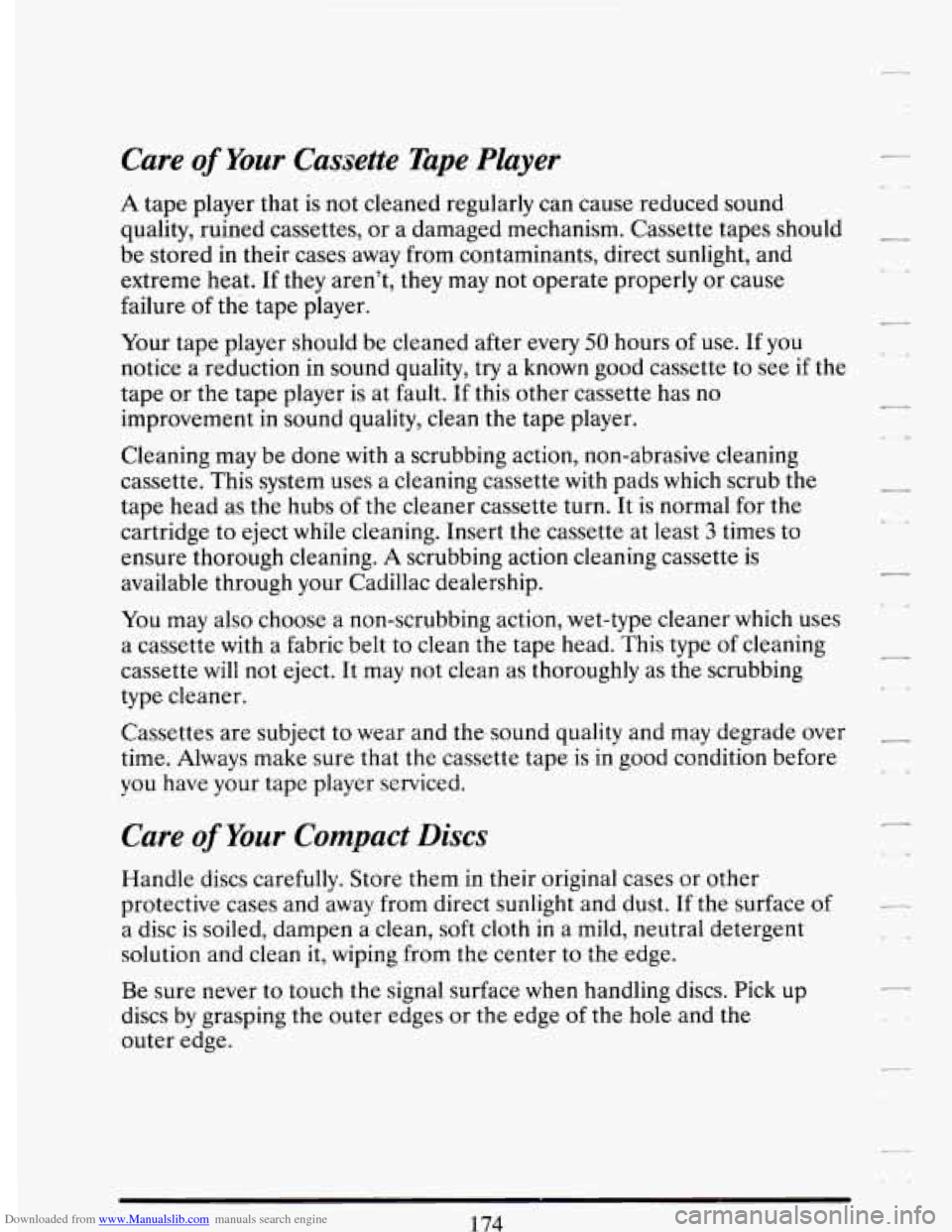
Downloaded from www.Manualslib.com manuals search engine Care of Your Cassette Tape Player
A tape player that is not cleaned regularly can cause reduced sound
quality, ruined cassettes, or a damaged mechanism. Cassette tapes should
be stored in their cases away from contaminants, direct sunlight, and
extreme heat. If they aren't, they may not operate properly or cause
failure
of the tape player.
Your tape player should be cleaned after every
50 hours of use. If you
notice
a reduction in sound quality, try a known good cassette to see if the
tape
or the tape player is at fault. If this other cassette has no
improvement
in sound quality, clean the tape player.
Cleaning may be done with a scrubbing action, non-abrasive cleaning
cassette. This system uses a cleaning cassette with pads which scrub the
tape head as the hubs of the cleaner cassette turn. It is normal for the
cartridge to eject while cleaning. Insert the cassette at least
3 times to
ensure thorough cleaning.
A scrubbing action cleaning cassette is
available through your Cadillac dealership.
You may also choose a non-scrubbing action, wet-type cleaner which uses
a cassette with a fabric belt to clean the tape head. This type
of cleaning
cassette will
not eject. It may not clean as thoroughly as the scrubbing
type cleaner.
Cassettes are subject
to wear and the,sound quality and may degrade over
time. Always make sure that the cassette tape is
in good condition before
you have your tape player serviced.
Care of Your Compact Discs
Handle discs carefully. Store them in their original cases or other
protective cases and away from direct sunlight and dust. If the surface
of
a disc is soiled, dampen a clean, soft cloth in a mild, neutral detergent
solution and clean it, wiping from the center
to the edge.
Be sure never
to touch the signal surface when handling discs. Pick up
discs by grasping the outer edges or the edge of the hole and the
outer edge.
174
r